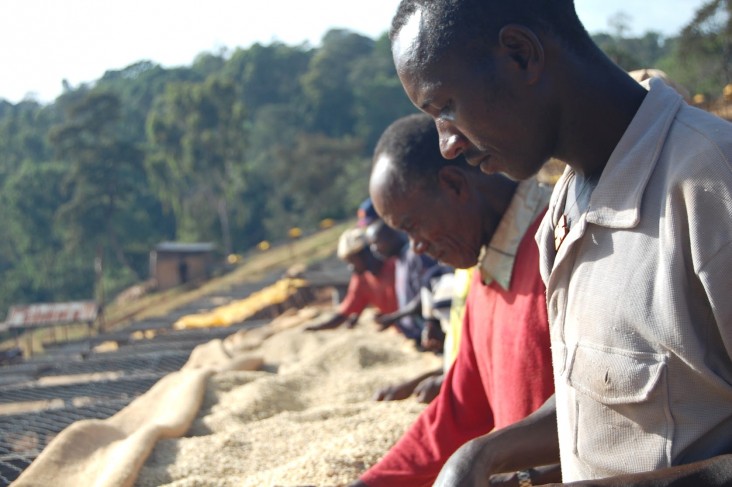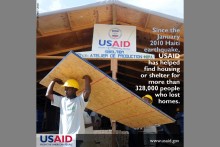Home » Reports & Data » Progress

Workers at the Kilensomokenisa Cooperative in the Southern Nations, Nationalities and People's Region of Ethiopia dry washed parchment Yirgacheffe coffee on top of raised drying beds.
Marcelo Pereira, USAID Agribus Market Develop
Here are just a few examples of what less than one percent of the total federal budget can accomplish, when it is dedicated to development assistance.
Health
Photo Gallery
Preventing Child and Maternal Deaths
- Since 2008, USAID's efforts in 25 priority countries have helped save the lives of 4.6 million children and 200,000 women.
- In 2016, USAID helped 82 million women and children access essential health services.
- In our priority countries, the percent of demand for family planning satisfied by a modern method has increased from 45% in 2010 to 51% in 2015.
- Since 2012, 25.3 million children have been vaccinated against deadly preventable diseases.
- In 2015, over 12 million children under-5 were reached with USG supported nutrition programs.
- More than 6.8 million malaria deaths were averted worldwide between 2001 and 2015, primarily among children under five years of age in sub-Saharan Africa with the greatest progress occurring after 2005, when U.S. President's Malaria Initiative (PMI) programs were launched.
Controlling the HIV/AIDS Epidemic
- As a result of PEPFAR, USAID and other implementing partners have:
- Supported lifesaving antiretroviral treatment for more than 11.5 million people
- Supported HIV counseling and testing for more than 74.3 million people, including 11.5 million pregnant women in FY 2016
- Reached more than 1 million adolescent girls and young women with HIV prevention interventions through the Determined, Resilient, Empowered, AIDS-free, Mentored and Safe (DREAMS) Initiative
Combatting Infectious Disease Threats
- FY 2015 investments in TB contributed to an estimated 48 million lives saved from 2000-2015, including people coinfected with HIV/AIDS, leading to a 22 percent decline in TB mortality and a 21 percent decline in TB incidence globally since 2000.
Food
- Forty-three of the top 50 consumer nations of American agricultural products were once U.S. foreign aid recipients. Between 1990 and 1993, U.S. exports to developing and transition countries increased by $46 billion.
- With the help of USAID, 21,000 farm families in Honduras have been trained in improved land cultivation practices which have reduced soil erosion by 70,000 tons.
- Agricultural research sponsored by the United States sparked the "Green Revolution" in India. These breakthroughs in agricultural technology and practices resulted in the most dramatic increase in agricultural yields and production in the history of mankind, allowing nations like India and Bangladesh to become nearly food self-sufficient.
- Early USAID action in southern Africa in 1992 prevented massive famine in the region, saving millions of lives.
- U.S. exports of food processing and packaging machinery have increased from about $100 million in 1986, to an estimated $680 million in 1994. This huge increase is due partly to USAID-funded projects that have increased supplies of agricultural raw materials for processing and have given potential processors the information, technical assistance and training they needed to start or expand their businesses.
- Investments by the United States and other donors in better seeds and agricultural techniques over the past two decades have helped make it possible to feed an extra billion people in the world.
Democracy & Self-Governance
- There were 58 democratic nations in 1980. By 1995, this number had jumped to 115 nations.
- USAID provided democracy and governance assistance to 36 of the 57 nations that successfully made the transition to democratic government during this period.
Sustainability & the Environment
- Over the past decade, USAID has targeted some $15 million in technical assistance for the energy sectors of developing countries. U.S. assistance has built a $50 billion annual market for private power. U.S. firms are capturing the largest share of these markets, out-competing Japan and Germany.
Economic Growth & Financial Independence
- Eighty thousand people and $1 billion in U.S. and Filipino assets were saved due to early warning equipment installed by USAID that warned that the Mount Pinatubo volcano was about to erupt in 1991.
- After initial USAID start-up support for loans and operating costs, Banco Solidario (BancoSol) became the first full-fledged commercial bank in Latin America dedicated to microbusiness. BancoSol serves about 44,000 small Bolivian businesses, with loans averaging $200 each. The bank now is a self-sustaining commercial lender that needs no further USAID assistance.
- Millions of entrepreneurs around the world (many of them women) have started or improved small businesses through USAID assistance.
Education
- Literacy rates are up 33 percent worldwide in the last 25 years, and primary school enrollment has tripled in that period.








Comment
Make a general inquiry or suggest an improvement.